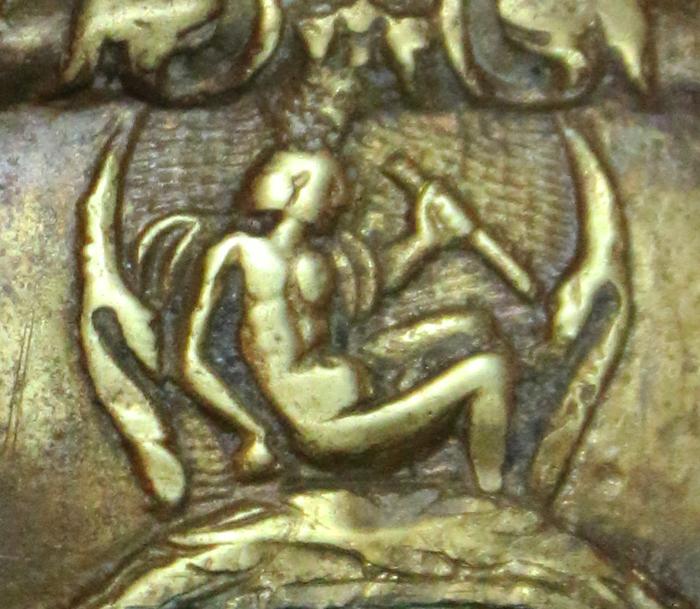A Most Interesting and Intriguing 18th Century Small Sword, circa 1770, with a Trefoil Colichemarde blade
Gilt hilt with numerous classical representations of male and female figures. The figures are intriguing to say the least, upon the double shell guard there are a pair of male and female figures, each holding classical noble sceptres, the male figure has a somewhat Egyptian hair style and a tall crown, but also bat type wings. The pommel has an embossed portrait bust of a classical king, and the quillon block has two classical figures, both with staff, one with a cloak one without, but intriguingly and rarely seen, the cloakless male figure has his [obvious] full compliment of 'gentleman's marital equipment' [see photo], which is most rare to see on antique weaponry. The sword bears a trefoil colichemarde blade that is beautifully inlaid with a 1.75 inch panel of copper-gold alloy in a geometric pattern. The grip is multi wire bound over wood that is a tad spaced now through age. The small sword or smallsword is a light one-handed sword designed for thrusting which evolved out of the longer and heavier rapier of the late Renaissance. The height of the small sword's popularity was between mid 17th and late 18th century. It is thought to have appeared in France and spread quickly across the rest of Europe. The small sword was the immediate predecessor of the French duelling sword (from which the épée developed) and its method of use—as typified in the works of such authors as Sieur de Liancour, Domenico Angelo, Monsieur J. Olivier, and Monsieur L'Abbat—developed into the techniques of the French classical school of fencing. Small swords were also used as status symbols and fashion accessories; for most of the 18th century anyone, civilian or military, with pretensions to gentlemanly status would have worn a small sword on a daily basis.
The small sword could be a highly effective duelling weapon, and some systems for the use of the bayonet were developed using the method of the smallsword as their foundation, (including perhaps most notably, that of Alfred Hutton).
The highly distinctive colishmarde blades appeared in 1680 and were popular during the next 40 years at the royal European courts. The colichemarde bladed swords had a special popularity with the officers of the French and Indian War period. Even George Washington had a very fine one just as this example.
The colichemarde descended from the so-called "transition rapier", which appeared because of a need for a lighter sword, better suited to parrying. It was not so heavy at its point; it was shorter and allowed a limited range of double time moves.The colichemarde in turn appeared as a thrusting blade too and also with a good parrying level, hence the strange, yet successful shape of the blade.
This sword appeared at about the same time as the foil. However the foil was created for practising fencing at court, while the colichemarde was created for dueling. With the appearance of pocket pistols as a self-defense weapon, the colichemardes found an even more extensive use in dueling.
This was achieved thanks to a wide forte (often with several fullers), which then stepped down in width after the fullers ended.The result of this strange shape was a higher maneuverability of the sword: with the weight of the blade concentrated in one's hand it became possible to maneuver the blade at a greater speed and with a higher degree of control, allowing the fencer to place a precise thrust at his/her adversary. The knuckle bow has been removed by design and there is no sharp tip point remaining to the overall russetted blade.
Overall 26.75 inches long overall, hilt 5.25 inches.
Code: 23962
595.00 GBP










